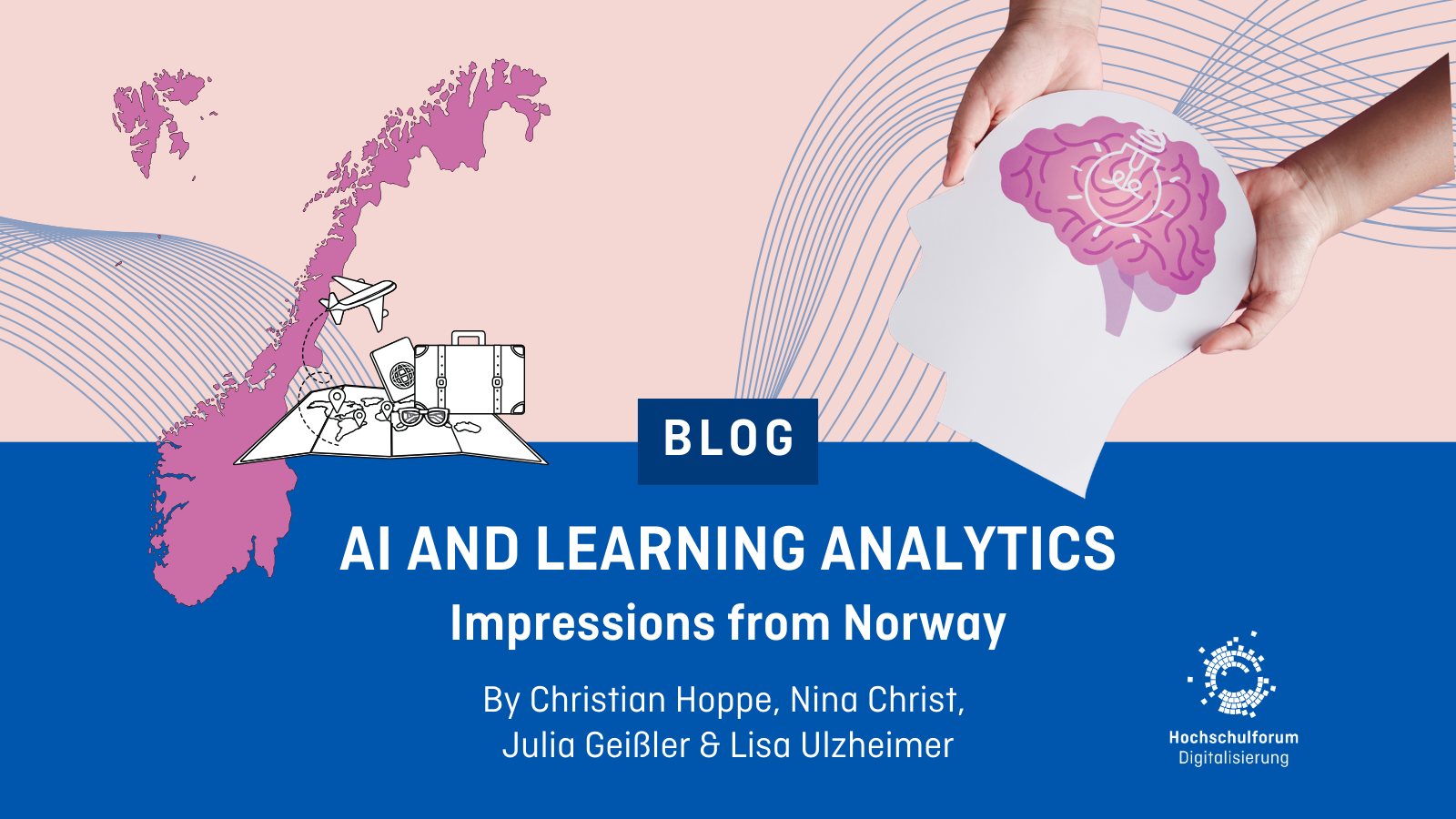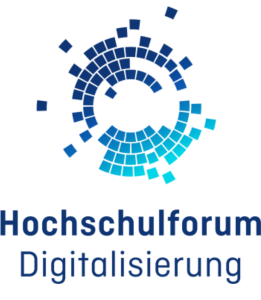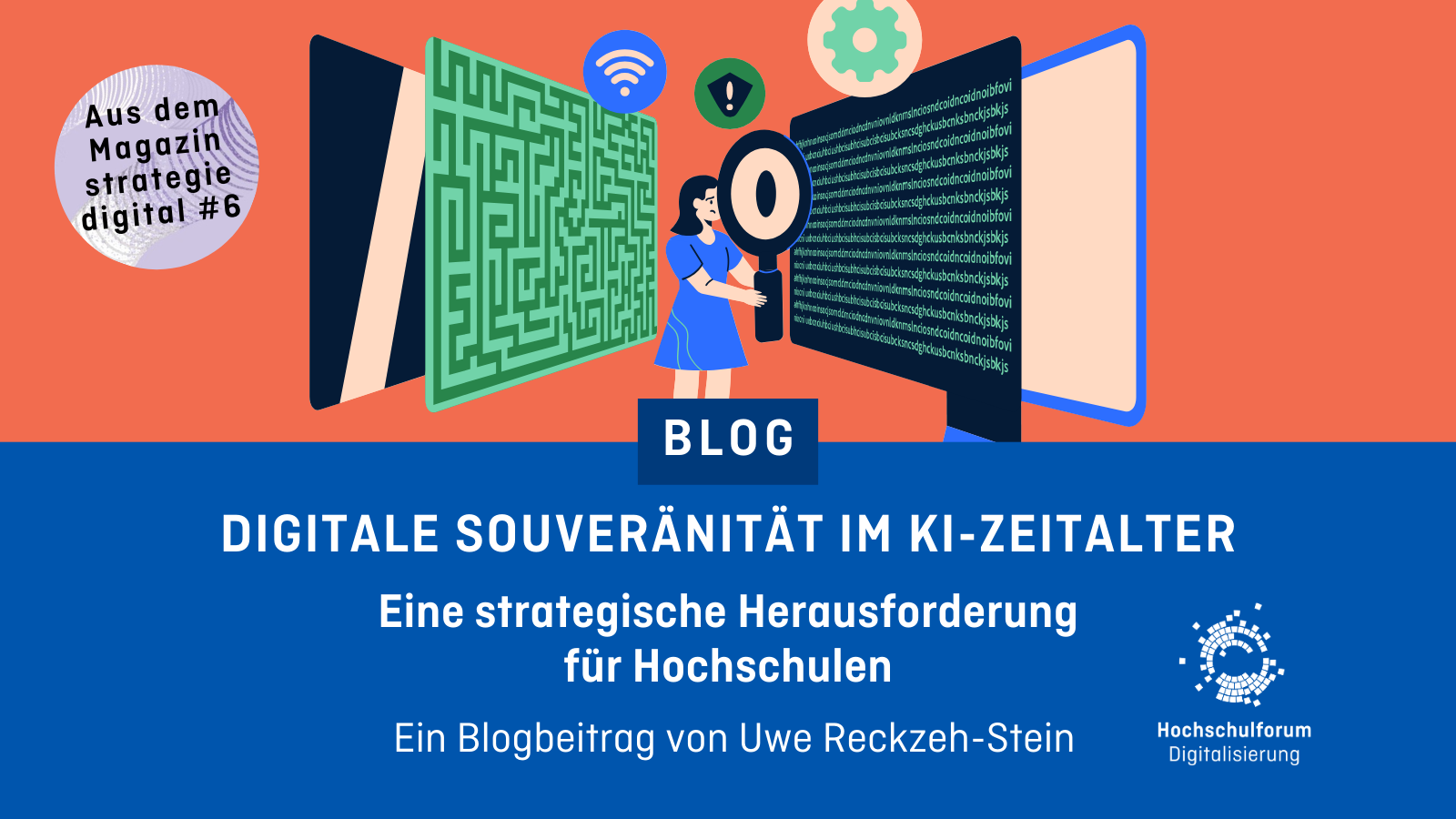AI and Learning Analytics – Impressions from Norway
AI and Learning Analytics – Impressions from Norway
26.08.25
In May 2025, we traveled – sponsored by the Hochschulforum Digitalisierung (HFD) as a delegation to the University of Bergen in Norway with many questions on the topics of “AI and learning analytics in the university teaching and learning context”. Our trip was characterized by a wealth of positive impressions and new insights.
As soon as we arrived at the station, we could sense Norway’s commitment to becoming one of the world’s leading digitalized countries by 2030: Surprisingly, there were no more paper tickets. Our delegation’s aim in Norway was not only to exchange experiences, but also to discuss and further develop specific ideas and approaches. Our deliberations focused on the following topics:
- Methodical-didactic approaches to the implementation and use of learning analytics and artificial intelligence (AI) in higher education
- Technical infrastructure concepts for learning analytics– and AI systems
- the development of a Learning Analytics Policy as a university-wide instrument for raising awareness
HK-dir and SIKT: Driving Forces behind Digitalization in Norway
During our trip, we realized what a central role HK-Dir (the Directorate for Higher and University Education in Norway) and SIKT (a state organization for the promotion of IT infrastructure) in the digital transformation of the Norwegian education system. This is not only to be seen in the school and university sector, but also includes the adult population.
HK-dir, the Norwegian Directorate for Higher Education and Skills, has a variety of tasks and roles that are central to the education sector in Norway:
- Consultant: HK-dir acts as an advisory body that draws on evidence-based reports to support higher education and skills development. Its recommendations are based on research and practical experience.
- Initiator: The Directorate promotes new initiatives and projects aimed at strengthening digital and AI skills in higher education.
- Coordinator: HK-dir coordinates and networks the various stakeholders in the education sector to enable an effective exchange of experience and resources. They work to develop common guidelines and framework conditions, for example with regard to examinations and AI.
SIKT (Norwegian Agency for Shared Services) provides support as a central technical interface by providing comprehensive IT infrastructures The development of secure and reliable networks is a particular focus. This serves the goal of enabling a far-reaching digitalization of teaching that is characterized by interoperability and user-friendliness. SIKT’s way of working is characterized by the following features:
- National IT and data infrastructure: SIKT is responsible for the development and maintenance of an efficient IT and data infrastructure, which forms the basis for the digital operation of universities and research institutions.
- Promotion of standardized IT solutions: You promote the introduction of standardized IT solutions, such as Canvas as a learning management system (LMS), in order to provide a uniform digital learning environment.
- Management of research data and publications: SIKT supports the management of research data and scientific publications to ensure that they are handled consistently and securely.
- Advice on data protection and legal issues: The agency offers comprehensive support and advice on data protection issues in order to guarantee the legally compliant use of technologies at universities.
- Product-oriented teams: These teams work closely with subject matter experts from the respective institutions to develop solutions based on the specific needs and requirements of the universities.
- Establishment of an AI lab and support for AI projects: SIKT is also involved in setting up AI labs and actively supports projects that research and promote the use of artificial intelligence in higher education.
We were impressed by the ability of these organizations to develop standardized IT solutions that not only ensure compliance and data protection, but also promote innovation and flexibility.
Learning Analytics and the Bridge to Practice
Before the current rise of artificial intelligence (AI), learning analytics (LA) was prioritized nationally as extremely important for the educational landscape. The idea was to sustainably improve the quality of teaching and learning through data-driven decisions. With the rise of the AI trend, prioritization has shifted.
Data analysis methods continue to offer promising approaches for optimizing learning processes and providing targeted support for learning at universities. In the SLATE Institute extensive research is being conducted in this area. SLATE is a Norwegian national center for learning analytics that deals with technological, pedagogical and legal aspects of AI and promotes the responsible use of these technologies in education. SLATE combines interdisciplinary research with policy advice and works nationally and internationally at the interface of education, technology and society. As a delegation, we were given an exciting insight into the day-to-day research work of the international and interdisciplinary team.
This also revealed a discrepancy between research and practice. At the state universities in Norway, including the University of Bergen, there are no specific documents such as policies or guidelines on learning analytics in teaching. This is due to the fact that there has hardly been any transfer to practice to date. In contrast, the BI Norwegian Business School in Oslo is working on a corresponding policy to enable the use of learning analytics while safeguarding students’ rights.
In order to make meaningful use of learning analytics, the actors involved must develop suitable skills. This includes, in particular, data literacy in order to enable and promote a reflective approach. In addition, the ability to understand and interpret visually processed data and derive measures from it is required, especially in the area of learning analytics.
In summary, it can be said that Norway is similarly advanced as Germany in the field of learning analytics in everyday university life. There are isolated lighthouse projects. However, no system is in widespread use. In addition, there is a skeptical to uncertain attitude towards questions of data security and, more fundamentally, the actual added value of learning analytics.
Artificial Intelligence @ UiB
The University of Bergen uses AI in a variety of ways to enrich education and research. One central aspect is the technical infrastructure, which includes its own interface “UiB Chat” (data protection-compliant based on Chat-GPT) and MS Copilot.
Each faculty has a specific AI policy to ensure the use of AI technologies in accordance with ethical and data protection standards. In addition, there is a “UiB AI” a coordinated board comprising members from various faculties to promote interdisciplinary collaboration.
Various institutions within the university are developing further education courses that address the application of AI in teaching and learning processes.
The university also has a strong research infrastructure for AI, which is supported by the SLATE Institute. The strategic orientation of several projects was particularly exciting: EduTrust AI examines trust in AI in an educational context as a social phenomenon, while AI Learn and AI Create analyze human-technological co-evolution in learning settings – from collaborative creativity to hybrid intelligence.
We also found the presentation of the chatbot Inez exciting. This is an AI-supported chatbot that was developed in the Lead AI project and acts as a creative workshop facilitator. The chatbot works collaboratively with groups, but cannot be interrupted spontaneously and tends to learn “bad habits”. Interaction with Inez is based on hybrid forms of collaboration in which a human works together with several AI agents (human-AI-AI co-creation). Emotional reactions such as fascination, frustration or even friendship with the chatbot have been observed. Although Inez can support creative processes, it has been shown that workshops with more than seven people, for example, are difficult to carry out. There is also a need for pedagogical framework concepts for the productive use of such AI systems. Inez is based on OpenAI technologies.
We also visited we visited the “UiB Learning Lab“which supports teaching, learning and innovation at the University of Bergen. Among other things, it offers media production (podcasts, videos, etc.), course development, workshops and seminars. Since its foundation in 2017, it has been a central component of university teaching and innovation support. In a matrix organization, around 25 colleagues from various administrative areas work together on topics such as university didactics, learning design, educational technologies and media production. The Learning Lab sees itself as a “working community” and collaborates with various university institutions on a project basis. We were particularly impressed by the matrix organizational model, which facilitates interdisciplinary collaboration. Among other things, introductory courses for employees on the subject of AI are planned there, as the prior knowledge of this target group varies greatly. The approach of providing managers with targeted training so that they can reflect on the potential and challenges of AI use cases with their teams is particularly exciting. During the exchange with the colleagues there, it also became clear that many challenges are similar. In Bergen, too, digital teaching is often still “nice to have” rather than standard and face-to-face teaching continues to dominate.
The University Pedagogy (UPED) offers a comprehensive continuing education program of 200 SWS. This continuing education program is mandatory for lecturers and is supported by university didactic consultations . One of these is the elective module “Using large language models and artificial intelligence for teaching and learning“. This module is designed to promote the practical use of AI in teaching projects and includes peer reviews and reflections on use cases.e.
Recommendations for Action
Our stay in Norway gave us numerous insights into the digitalization of the German higher education sector. We would like to summarize the insights we gained in the form of concrete recommendations for the further development of digitalization in Germany:
1. Promotion of Interdisciplinary Cooperation
The matrix organization at the University of Bergen has convinced us that interdisciplinary collaboration is essential for innovation in education. We therefore recommend the introduction of similar structures at German universities that enable subject experts to pool their expertise and work together in dynamic projects. These teams should consist of representatives from different disciplines in order to integrate different perspectives and develop creative solutions.
2. Expansion of AI Literacy and Data Competence
A key insight from our trip was the vital importance of AI literacy and data literacy for all educational stakeholders. There is an urgent need to systematically anchor both topics in curricula and not just see them as an optional additional qualification. While there is already a lot of international research and pilot projects in the field of learning analytics, practical application often falls short of expectations – not least because there is a lack of broad expertise in dealing with AI-supported processes and a lack of acceptance. Data protection plays a key role here and requires special attention. It became clear that the promotion of data literacy is fundamental for all educational stakeholders in order to be able to use and evaluate data-based systems such as learning analytics responsibly.
In this context, the Norwegian digitalization strategy particularly emphasizes the need to strengthen AI skills at all levels: students, teachers and university management should acquire basic knowledge about how AI and data analysis work, possible applications, risks and ethical issues. Pioneers such as the universities in Bergen (UiB) and Agder (UiA) are already integrating digital and AI-related content into all degree programs in order to ensure relevance to the job market and the ability to act in society. In addition to this, specialist skills are to be developed for the targeted use of AI in teaching, learning space design, examination practice and research. Another focus is on training in legal and ethical framework conditions as well as the coordination of AI initiatives within universities. For Germany, a comparable development of skills across all areas of education is also urgently needed in order to make sustainable and responsible use of the opportunities offered by AI technologies.
3. Holistic Digitization Strategies
A comprehensive digitalization strategy similar to Norway’s by 2030 would be beneficial for Germany. With its national digitalization strategy, Norway is pursuing the ambitious goal of becoming one of the most digitalized countries in the world by 2030. The strategy encompasses the public, private and civil society sectors and places a particular focus on the ethical and safe use of artificial intelligence. A national AI infrastructure is to be established by 2030, which will provide access to basic models in Norwegian and Sámi languages and adapted to Norwegian social conditions, among other things. Alongside this, the government is planning measures such as the legal clarification of text and data usage, the implementation of the EU AI Regulation into national law and the establishment of a research center for AI in society. The higher education sector also has its own strategy for digital transformation (2021-2025), which is closely linked to the national digitalization strategy. The overarching goals of the current long-term research and education strategy (2023-2032) are to strengthen competitiveness and innovation, social and environmental impact as well as the quality and accessibility of education and research.
The Norwegian strategy is characterized by the fact that it not only addresses technological developments, but also explicitly focuses on ethical, social and educational policy issues. It formulates clear visions and achievable milestones, such as the use of AI in university teaching and the establishment of a national data infrastructure for the education sector.
For Germany, a comparable national strategy could help to bundle the currently still highly fragmented activities on digitalization in the education sector and define a common direction. Especially for sensitive topics such as the use of learning analytics and AI in teaching, it would be important to establish an overarching guideline that provides orientation for universities and educational institutions. In addition to technological and legal aspects, questions of digital sovereignty, ethics and participation should also be systematically taken into account. An accompanying monitoring and advisory body – consisting of experts from science, technology, law and society – could ensure that the strategy remains not only ambitious, but also practical and connectable. A look at Norway shows that such an integrated approach can be possible and effective.
4. Improving the Practical Implementation of Learning Analytics
Despite numerous research initiatives, there is still a gap in the practical implementation of learning analytics, similar to those in Germany. Our recommendation is to establish closer partnerships with research centers, such as SLATEThis could help to integrate research findings directly into teaching. The added value gained here can be demonstrated through targeted pilot projects.
5. Data Management and Data Protection
It is crucial that educational institutions develop a uniform and sustainable approach to data management and data ethics in order to ensure the responsible use of AI and learning analytics in research and teaching in compliance with data protection regulations. Currently, there are still very different regulations and uncertainties in many places, especially when it comes to handling personal learning and performance data. A clearly defined and transparently published institutional framework can not only create legal certainty here, but also increase acceptance among teachers, students and staff. It makes sense to consistently take into account existing national and European requirements such as the GDPR and to translate them into university-specific guidelines.
At the same time, it makes sense to collaborate with leading technological institutions and university networks. – also internationally – to benefit from their experience, solutions and standards. The exchange with Norwegian universities during the trip showed how valuable such collaborations can be. Particularly in the areas of technical infrastructure, governance models and ethical support for AI systems, synergy effects can be achieved through international networking. In this way, universities can not only secure their own digital sovereignty, but also create innovation-friendly and responsible framework conditions for the use of AI in academic education. The mindset of “digital and modern teaching with data protection” and not despite data protection or prevented by data protection was a refreshing insight in Norway. This also includes seeing visible data as an opportunity for (personal) development and assistance and not just focusing on the negative side of a potentially transparent student.
6. Involvement of Skeptical Voices and Co-Design
Sceptical voices should be included in the digitalization process from the outset in order to reduce concerns about new technologies and increase acceptance. An open dialog that promotes critical thinking can create a constructive culture of discussion and alleviate fears and prejudices. This aspect became particularly clear in the Norwegian AI strategy paper for universities (HK-dir paper on AI in higher education), which emphasizes how important it is tosystematically includeperspectives that are critical of technology. This concern can certainly also be transferred to the German context, as there is also a broad consensus here that a successful and responsible approach to AI and learning analytics can only be achieved if different perspectives and reservations are taken into account at an early stage. However, when asked how Norwegian colleagues implement this in practice, it became clear that there is a lack of tried-and-tested formats. The situation is similar here in Germany. Therefore, innovative and low-threshold formats are needed to introduce skeptics in particular to the topic, productively integrate their perspectives and thus create a common basis for discussion and design for the use of AI technologies in higher education.
7. Resource Optimization through Cooperation
Finally, the importance of cooperation and the exchange of resources between institutions should not be underestimated. A collaborative approach to the use and development of technologies could minimize infrastructure costs and accelerate the achievement of common goals.
Conclusion
With these recommendations for action, we want to show how Germany can learn from the digital advances in Norway and adapt the underlying strategies and measures to our own needs. There is a great opportunity to drive forward the digitalization of the education sector and thereby improve the quality of teaching in the long term.
Our trip to Norway gave us valuable insights into the strategic and responsible digitalization of the higher education sector. We were particularly impressed by the integrated approach with which topics such as AI, learning analytics, data protection and ethics are considered together and translated into national and university-specific strategies. The Norwegian digitalization strategy up to 2030 sets clear goals, promotes AI literacy and data competence at all levels and emphasizes the inclusion of critical voices from the outset. While some practical implementations are still being developed in Norway, we were able to take away valuable impulses and concrete approaches for the German higher education landscape – for example, to establish reliable structures for data management, to strengthen digital future skills and to promote a responsible culture of discussion around AI in teaching.
Further information on our discussion partners and the institutions visited can be found on the linked Taskcards-Board. This was continuously updated and supplemented during the trip.
Acknowledgments
We would like to thank our Norwegian discussion partners, who gave us exciting insights into their work and perspectives on the use of artificial intelligence and learning analytics in education.
Our very special thanks go to Barbara Wasson (Slate Institute at the University of Bergen), who welcomed us with great warmth and was instrumental in organizing this delegation trip. Thanks to her impressive network, we were able to talk to numerous experts and benefit from a wide range of impulses.
Last but not least, we would like to thank Hochschulforum Digitalisierung (HFD) for making this trip possible.
Authors

Christian Hoppe heads the e-learning department at the University Didactics Center at the Technical University of Darmstadt. He is responsible for coordinating the central services and innovation projects in the field of digitally-supported teaching.

Nina Christ works at RheinMain University of Applied Sciences in Wiesbaden in the Department of Studies and Teaching. Her focus is on supporting lecturers in media didactics – particularly in the use of artificial intelligence in university teaching, which she supports in an advisory and conceptual capacity.

Julia Geissler is part of the team at the Department of Teaching and Learning at RheinMain University of Applied Sciences in Wiesbaden. She supports lecturers in their day-to-day media didactic advice and contributes her expertise to the further development of the digital infrastructure. Her thematic focuses range from gamification in teaching to the use of learning analytics to optimize teaching and learning processes.

Lisa Ulzheimer also works in the Department of Studies and Teaching at RheinMain University of Applied Sciences in Wiesbaden. She is involved in both media didactic consulting and the further development of the technical infrastructure – with a particular focus on the use of artificial intelligence in teaching contexts.





 Michael Siegel
Michael Siegel 
 Andreas Giesbert
Andreas Giesbert 
 Uwe Reckzeh-Stein
Uwe Reckzeh-Stein 